Seasonality and Nutrition-Sensitive Agriculture in Kenya: Evidence from Mixed-Methods Research in Rural Lake Naivasha Basin
Abstract
1. Introduction
2. Theoretical Framework and Variable Selection
Explanatory Variables
3. Data Collection and Estimation Methodology
4. Results and Discussion
4.1. Crop Diversification
4.2. Use of Crop Production
4.3. Income and Food and Non-Food Expenditure
4.4. Household Agricultural Assets
5. Conclusions
Funding
Conflicts of Interest
References
- Hodge, J.; Herforth, A.; Gillespie, S.; Beyero, M.; Wagah, M.; Semakula., R.M. Is There an Enabling Environment for Nutrition-Sensitive Agriculture in East Africa? Stakeholder Perspectives from Ethiopia, Kenya, and Uganda. Food Nutr. Bull. 2015, 36, 503–519. [Google Scholar] [CrossRef] [PubMed]
- FAO. Improving Diets through Nutrition-Sensitive Agriculture. 2014. Available online: http://www.fao.org/about/meetings/icn2/news/news-detail/en/c/261494/ (accessed on 1 October 2019).
- United Nations. Resolution Adopted by the General Assembly on 25 September 2015. Transforming Our World: The 2030 Agenda for Sustainable Development. 2015. Available online: https://www.un.org/ga/search/view_doc.asp?symbol=A/RES/70/1&Lang=E (accessed on 1 October 2019).
- Rampa, F.; van Seters, J. Toward the Development and Implementation of CAADP Regional Compacts and Investment Plans: The State of Play; European Center for Development Policy Management (ECDPM): Maastricht, The Netherlands, 2013. [Google Scholar]
- Ruel, M.T.; Quisumbinga, A.R.; Balagamwala, M. Nutrition-sensitive agriculture: What have we learned so far? Glob. Food Secur. 2018, 17, 128–153. [Google Scholar] [CrossRef]
- Carletto, C.; Ruel, M.; Winters, P.; Zezza, A. Farm-level pathways to improved nutritional status: Introduction to the special issue. J. Dev. Stud. 2015, 51, 945–957. [Google Scholar] [CrossRef]
- Jones, A.D. Critical review of the emerging research evidence on agricultural biodiversity, diet diversity, and nutritional status in low- and middle-income countries. Nutr. Rev. 2017, 75, 769–782. [Google Scholar] [CrossRef]
- Leroy, J.L.; Ruel, M.; Frongillo, E.A.; Harris, J.; Ballard, T.J. Measuring the Food Access Dimension of Food Security: A Critical Review and Mapping of Indicators. Food Nutr. Bull. 2015, 36, 167–195. [Google Scholar] [CrossRef]
- Sassi, M. Economic and health determinants of child nutritional status in the Malawian district of Salima. Eur. J. Dev. Res. 2014, 26, 761–782. [Google Scholar] [CrossRef]
- Sassi, M. Seasonality and Trends in Child Malnutrition: Time-Series Analysis of Health Clinic Data from the Dowa District of Malawi. J. Dev. Stud. 2015, 51, 1667–1682. [Google Scholar] [CrossRef]
- Hirvonen, K.; Taffesse, A.S.; Worku Hassen, I. Seasonality and household diets in Ethiopia. Public Health Nutr. 2016, 19, 1723–1730. [Google Scholar] [CrossRef]
- Ayenew, H.Y.; Biadgilign, S.; Schickramm, L.; Abate-Kassa, G.; Sauer, J. Production diversification, dietary diversity and consumption seasonality: Panel data evidence from Nigeria. BMC Public Health 2018, 18, 988. [Google Scholar]
- Becquey, E.; Delpeuch, F.; Konaté, A.M.; Delsol, H.; Lange, M.; Zoungrana, M.; Martin-Prevel, Y. Seasonality of the dietary dimension of household food security in urban Burkina Faso. Br. J. Nutr. 2012, 107, 1860–1870. [Google Scholar] [CrossRef]
- Ecker, O. Agricultural transformation and food and nutrition security in Ghana: Does farm production diversity (still) matter for household dietary diversity? Food Policy 2018, 79, 271–282. [Google Scholar] [CrossRef]
- Pinstrup-Andersen, P. Can agriculture meet future nutrition challenges? Eur. J. Dev. Res. 2013, 25, 5–12. [Google Scholar] [CrossRef]
- Ghawana, T. Flowering Economy of Naivasha. Impacts of Major Farming Systems on the Local Economy; International Institute for Geo-Information Science and Earth Observation Enschede: Enschede, The Netherlands, 2008. [Google Scholar]
- Fan, S.; Yosef, S.; Pandya-Lorch, R. Seizing the Momentum to Reshape Agriculture for Nutrition. In Agriculture for Improved Nutrition: Seizing the Momentum; Fan, S., Yosef, S., Pandya-Lorch, R., Eds.; CAB International: Boston, MA, USA, 2019; pp. 1–15. [Google Scholar]
- Headey, D.; Chiu, A.; Kadiyala, S. Agriculture’s Role in the Indian Enigma: Help or Hindrance to the Undernutrition Crisis? IFPRI Discussion Paper 01085; International Food Policy Research Institute: Washington, DC, USA, 2011. [Google Scholar]
- Hoddinot, J.; Headey, D.; Dereje, M. Cows, Missing Milk Markets, and Nutrition in Rural Ethiopia. J. Dev. Stud. 2015, 51, 958–975. [Google Scholar] [CrossRef]
- Ruel, M. Is Dietary Diversity an Indicator of Food Security or Dietary Quality? A Review of Measurement Issues and Research Needs; FCND Discussion Paper n. 140; International Food Policy Research Institute: Washington, DC, USA, 2002. [Google Scholar]
- Romeo, A.; Meerman, J.; Demeke, M.; Scognamillo, A.; Asfaw, S. Linking farm diversification to household diet diversification: Evidence from a sample of Kenyan ultra-poor farmers. Food Secur. 2016, 8, 1069–1085. [Google Scholar] [CrossRef]
- Sassi, M. Understanding Food Insecurity. Key Features, Indicators, and Response Design; Springer: Berlin, Germany, 2018. [Google Scholar]
- WFP, Vulnerability Analysis and Mapping. Food Consumption Analysis Calculation and Use of the Food Consumption Score in Food Security Analysis; United Nations World Food Programme: Rome, Italy, 2008. [Google Scholar]
- Jones, A.D.; Shrinivas, A.; Bezner-Kerr, R. Farm production diversity is associated with grater household dietary diversity in Malawi: Findings from nationally representative data. Food Policy 2014, 46, 1–12. [Google Scholar] [CrossRef]
- Coates, J.; Lorge Rogers, B.; Webb, P.; Maxwell, D.; Houser, R.; McDonald, C. Diet Diversity Study; World Food Programme, Emergency Needs Assessment Service (ODAN): Rome, Italy, 2007. [Google Scholar]
- Wiesmann, D.; Bassett, L.; Benson, T.; Hoddinott, J. Validation of the World Food Programme’s Food Consumption Score and Alternative Indicators of Household Food Security; IPRI Discussion Paper 00870; International Food Policy Research Institute (IFPRI): Washington, DC, USA, 2009. [Google Scholar]
- Islam, A.H.M.S.; von Brown, J.; Thorne-Luman, A.L.; Ahmed, A.U. Farm diversification and food and nutrition security in Bangladesh: Empirical evidence from nationally representative household panel data. Food Secur. 2018, 10, 701–720. [Google Scholar] [CrossRef]
- Koppmair, S.; Kassie, M.; Qaim, M. Farm production, market access and dietary diversity in Malawi. Public Health Nutr. 2016, 20, 325–335. [Google Scholar] [CrossRef]
- Hagenaars, A.; de Vos, K.; Zaidi, M.A. Poverty Statistics in the Late 1980s: Research Based on Micro-Data; Office for Official Publications of the European Communities: Luxembourg, 1994. [Google Scholar]
- Pitt, M.M.; Rosenzweig, M.R. Health and Nutrient Consumption Across and Within Farm Households. Rev. Econ. Stat. 1985, 67, 212–223. [Google Scholar] [CrossRef]
- Arias, P.; Hallam, D.; Krivinos, E.; Morrison, J. Smallholder Integration in Changing Food Markets; FAO: Rome, Italy, 2013. [Google Scholar]
- Poole, N. Smallholder Agriculture and Market Participation; Food and Agriculture Organization of the United Nations and Practical Action Publishing: Rome, Italy, 2017. [Google Scholar]
- Cochran, W.G. Sampling Techniques, 3rd ed.; John Wiley & Sons: New York, NY, USA, 1997. [Google Scholar]
- KNBS. Kenya Demographic and Health Survey, 2014; Kenya National Bureau of Statistics: Nairobi, Kenya, 2014.
- Sibhatu, K.T.; Krishna, V.V.; Qaim, M. Production diversity and dietary diversity in smallholder farm households. Proc. Natl. Acad. Sci. USA 2015, 112, 10657–10662. [Google Scholar] [CrossRef]
- Pellegrini, L.; Tasciotti, L. Crop diversification, dietary diversification and agricultural income: Empirical evidence from eight developing countries. Can. J. Dev. Stud. 2014, 35, 211–227. [Google Scholar] [CrossRef]
- Barrett, C.B.; Reardon, T.; Webb, P. Nonfarm income diversification and household livelihood strategies in rural Africa: Concepts, dynamics, and policy implications. Food Policy 2001, 26, 315–331. [Google Scholar] [CrossRef]
- Oke, A.; Walumbwa, F.; Yan, T.; Idiagbon-Oke, M.; Ojode, L.A. Linking economic status with technology adoption in three emerging economies of Sub-Saharan Africa. J. Manuf. Technol. Manag. 2014, 25, 49–68. [Google Scholar] [CrossRef]
- Sohoulande Djebou, D.C.; Price, E.; Kibriya, S.; Ahn, J. Comparative Analysis of Agricultural Assets, Incomes and Food Security of Rural Households in Ghana, Senegal and Liberia. Agriculture 2017, 7, 38. [Google Scholar] [CrossRef]
- Devereux, S.; Longhurst, R. Incorporating Seasonality into Agricultural Project Design and Learning. IDS Bull. 2010, 41, 88–95. [Google Scholar] [CrossRef]
- Abrams, L. Unlocking the Potential of Enhanced Rainfed Agriculture; Report no. 39; SIWI: Stockholm, Sweden, 2018. [Google Scholar]
- Nwachukwu, J.U. Technology Adoption and Agricultural Development in Sub-Saharan Africa (SSA): A Nigerian Case Study. Cult. Relig. Stud. 2017, 5, 371–385. [Google Scholar]
- Khandker, S.R.; Mahmud, W. Seasonal Hunger and Public Policies: Evidence from Northwest Bangladesh; The World Bank: Washington, DC, USA, 2012. [Google Scholar]
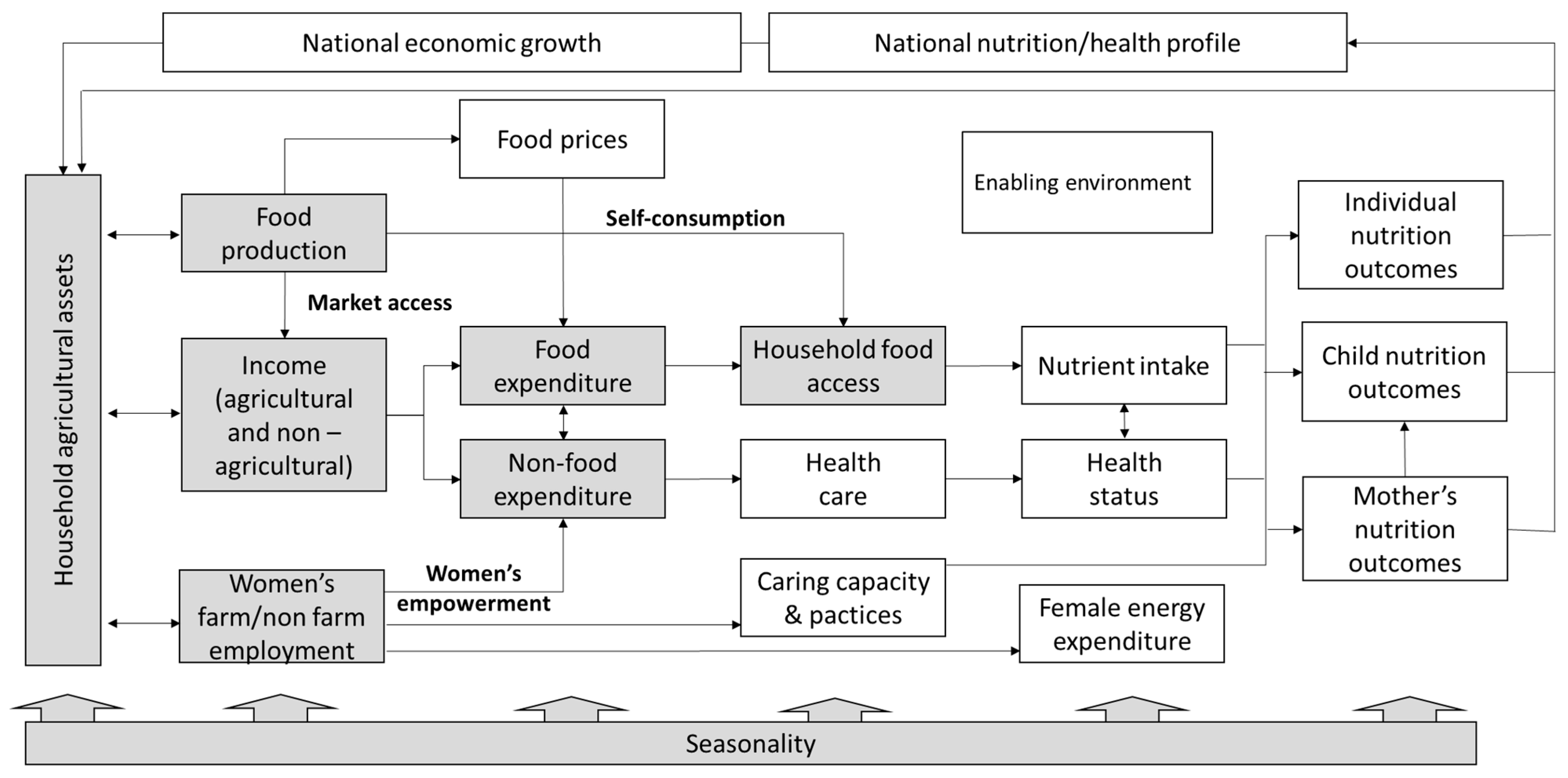
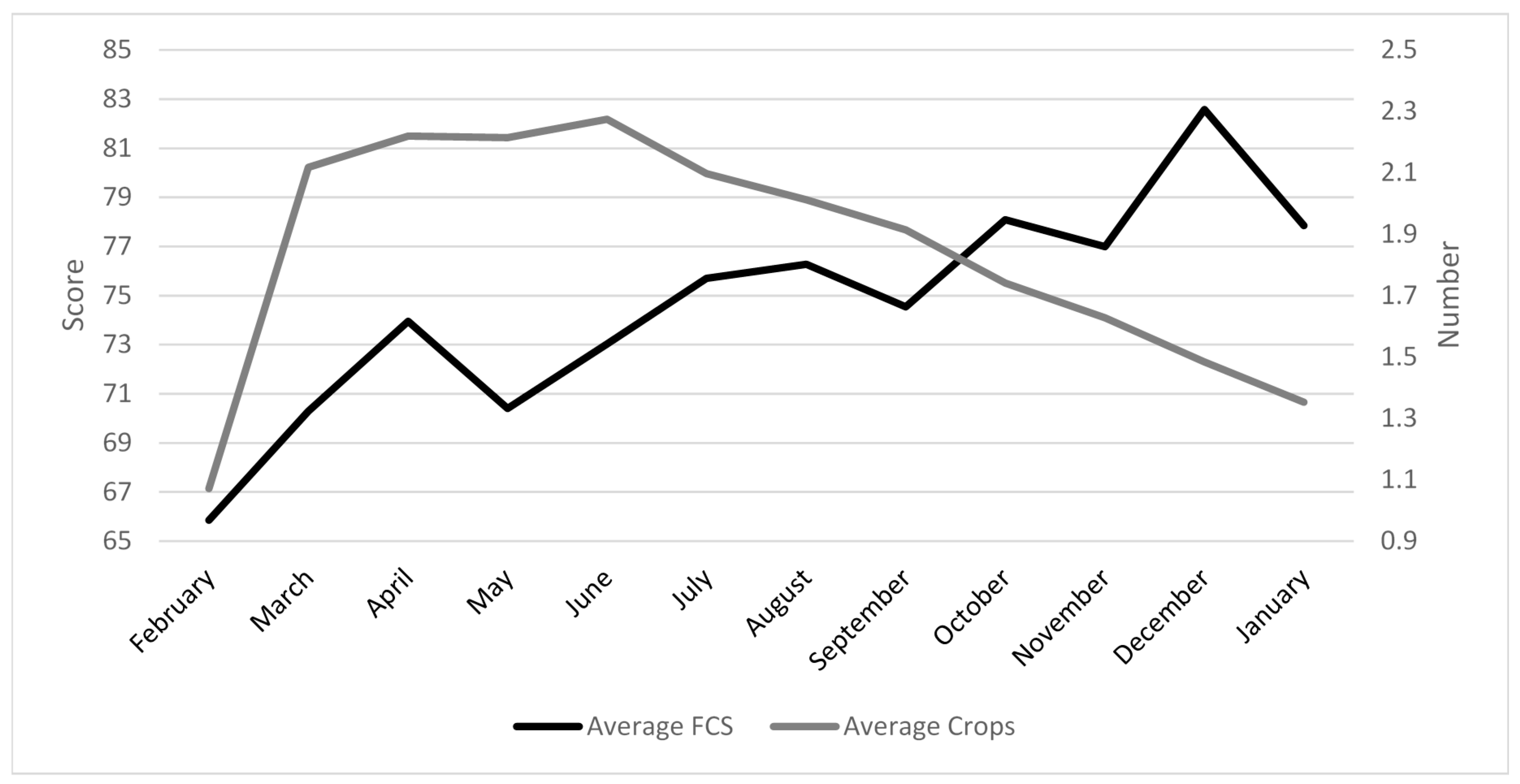
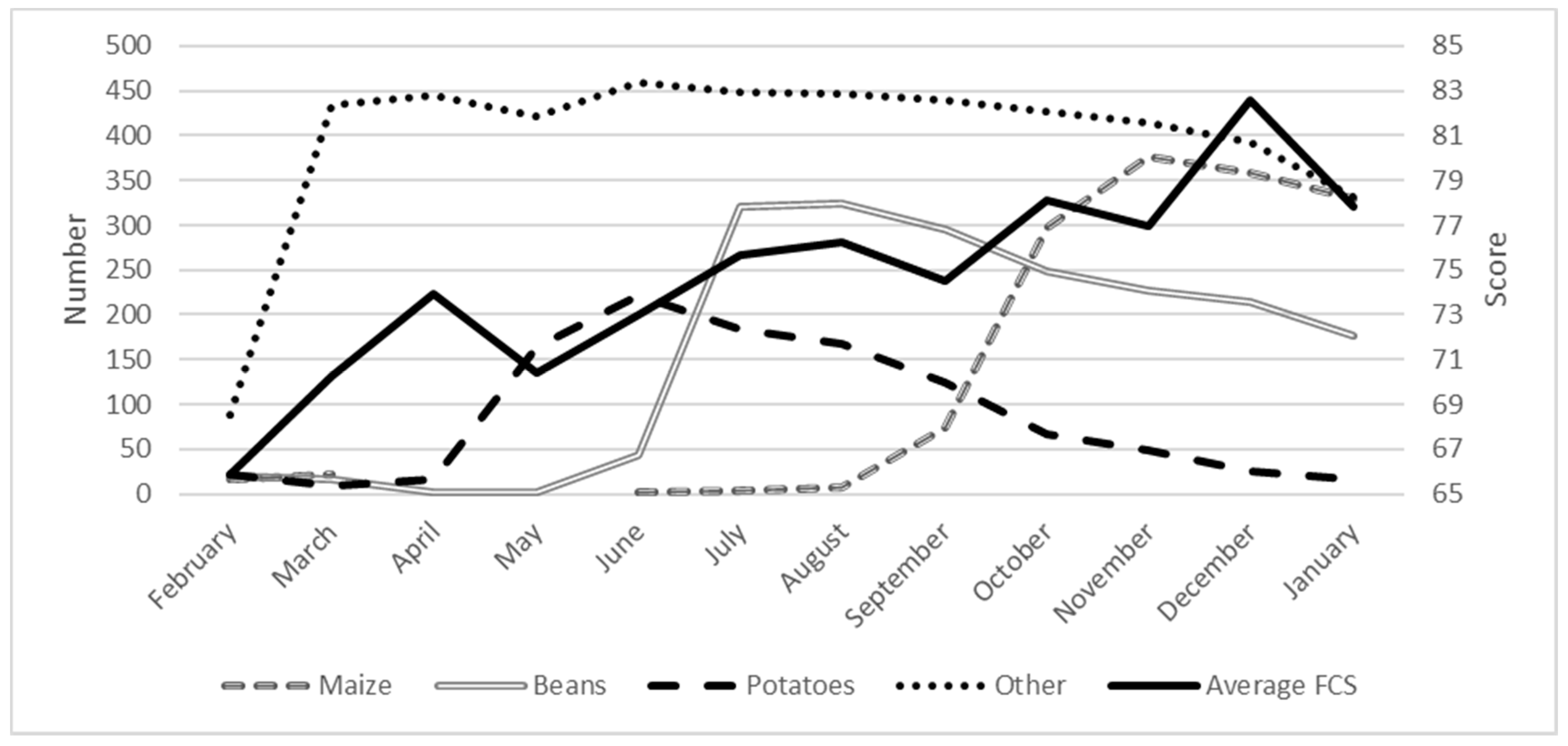
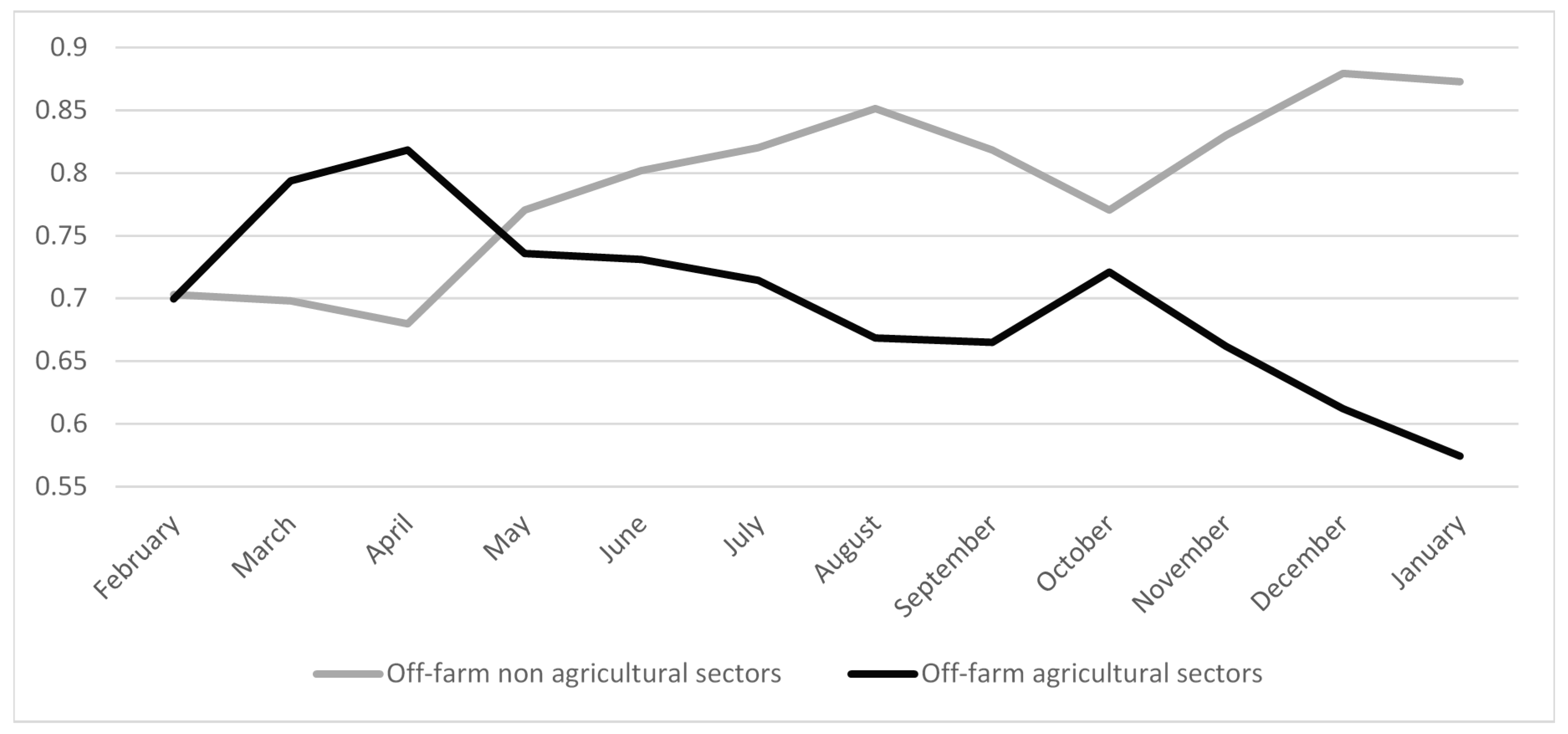
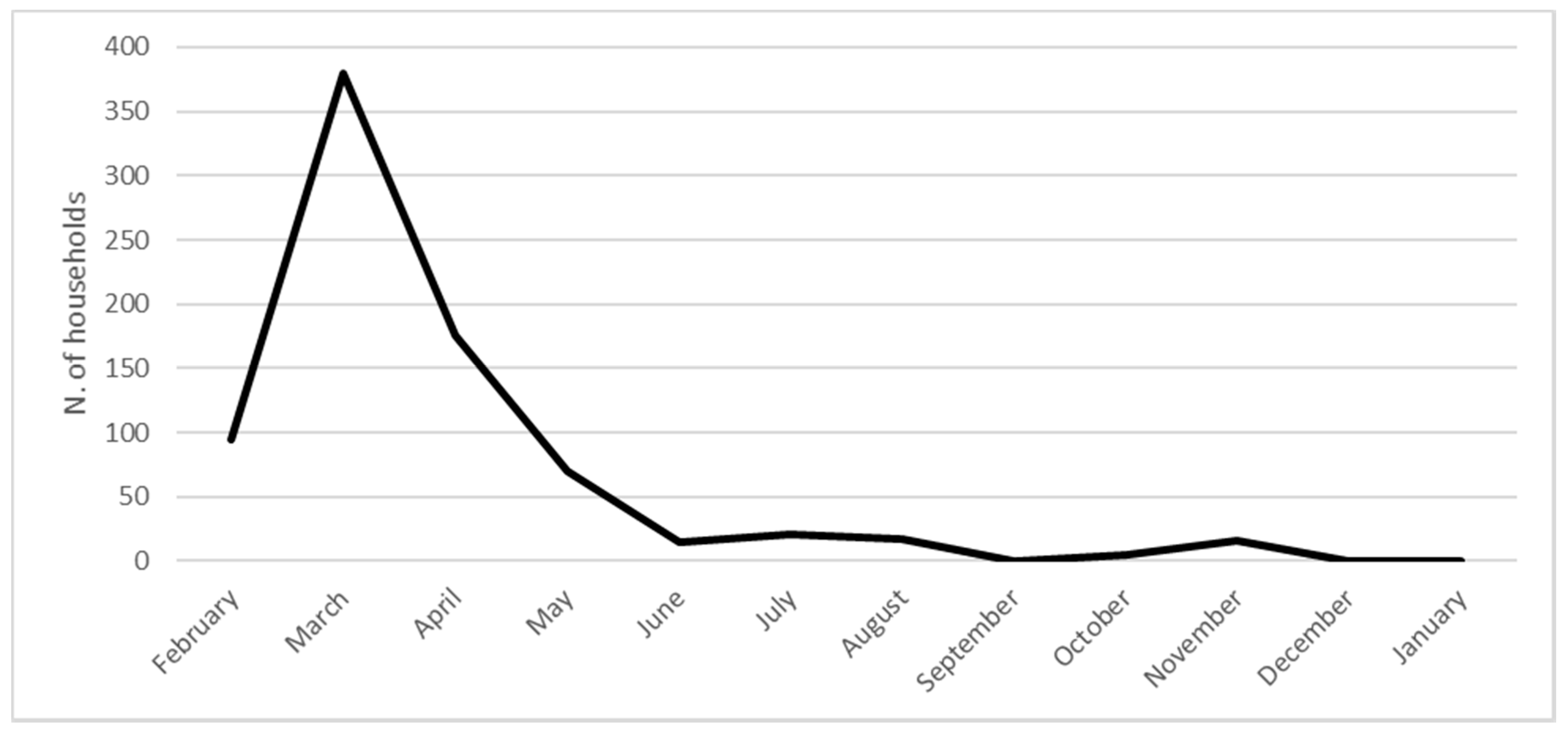
| Variable | Mean | Standard Deviation | Minimum | Maximum |
|---|---|---|---|---|
| Food Consumption Score (FCS) | 74.626 | 15.559 | 6 | 112 |
| Crop production | ||||
| Number of crops harvested | 1.513 | 1.278 | 0 | 7 |
| Household agricultural assets | ||||
| Production assets index | 0.001 | 0.855 | −1.117 | 3.218 |
| Input use | 0.109 | 0.311 | 0 | 1 |
| Savings | 0.110 | 0.314 | 0 | 1 |
| HH size (adult equivalent) | 2.126 | 0.804 | 1 | 5 |
| HH Dependency ratio | 39.708 | 29.301 | 0 | 100 |
| Age | 48.040 | 16.407 | 16 | 94 |
| Gender | 0.303 | 0.459 | 0 | 1 |
| Literacy | 0.881 | 0.323 | 0 | 1 |
| Marital status | 0.645 | 0.478 | 0 | 1 |
| Health status | 0.145 | 0.352 | 0 | 1 |
| Use of crop production | ||||
| Self-consumption | 0.091 | 0.222 | 0 | 6 |
| Market access | 0.101 | 0.651 | 0 | 33.333 |
| Market access Maize | 0.020 | 0.155 | 0 | 11.111 |
| Market access Beans | 0.022 | 0.419 | 0 | 29.167 |
| Market access Potatoes | 0.010 | 0.068 | 0 | 4.167 |
| Market access Other crops | 0.013 | 0.072 | 0 | 1.000 |
| Total income | ||||
| Income first quantile | 0.200 | 0.400 | 0 | 1 |
| Income second quantile | 0.199 | 0.399 | 0 | 1 |
| Income third quantile | 0.200 | 0.400 | 0 | 1 |
| Income fourth quantile | 0.199 | 0.399 | 0 | 1 |
| Income fifth quantile | 0.199 | 0.399 | 0 | 1 |
| Non-farm income | ||||
| N. HH members employed in off-farm agric. sectors | 0.565 | 0.719 | 0 | 4 |
| N. HH members employed in off-farm non-agric. sectors | 0.564 | 0.786 | 0 | 5 |
| Women’s empowerment | ||||
| N. women employed in off-farm agric. Sectors | 0.699 | 0.704 | 0 | 4 |
| N. woman employed in off-farm non-agric. Sectors | 0.791 | 0.773 | 0 | 5 |
| Use of income | ||||
| Log food expenditure | 6.542 | 1.078 | 0 | 11.135 |
| Log non-food expenditure | 7.222 | 0.975 | 0 | 11.861 |
| Price index | 67.024 | 14.754 | 10 | 152.857 |
| Seasonality | ||||
| Hunger season | 0.25 | 0.433 | 0 | 1 |
| Maize harvesting | 0.204 | 0.4032 | 0 | 1 |
| Potatoes harvesting | 1.465 | 0.353 | 0 | 1 |
| Beans harvesting | 0.259 | 0.438 | 0 | 1 |
| Other crops harvesting | 0.903 | 1.125 | 0 | 1 |
| Variable | Model 1 | Model 2 | Model 3 | Model 4 |
|---|---|---|---|---|
| Crop production | ||||
| Number of crops harvested | 3.460 *** (0.536) | 3.429 *** (0.445) | 3.433 *** (0.529) | 3.577 *** (0.539) |
| Number of crops harvested squared | −0.691 *** (0.128) | −0.660 *** (0.110) | −0.693 *** (0.127) | −0.705 *** (0.129) |
| HH agricultural assets | ||||
| Production assets index | 1.159 ** (0.500) | 1.149 *** (0.396) | 0.955 * (0.491) | 1.212 ** (0.501) |
| Input use | −1.231 * (0.687) | −1.242 ** (0.543) | −1.428 ** (0.685) | −1.162 * (0.687) |
| Savings | 3.273 *** (0.646) | 3.287 *** (0.587) | 2.961 *** (0.644) | 3.257 *** (0.649) |
| HH size adult equivalent | −1.790 ** (0.754) | −1.706 *** (0.621) | −1.627 ** (0.714) | −1.208 (0.763) |
| Dependency ratio | 0.043 (0.027) | 0.042 * (0.023) | 0.044 * (0.026) | 0.031 (0.027) |
| Age | 0.156 (0.227) | 0.162 (0.227) | 0.200 (0.235) | 0.151 (0.223) |
| Age squared | −0.003 (0.002) | −0.003 (0.002) | −0.003 (0.002) | −0.003 (0.002) |
| Gender | −1.941 (2.438) | −1.956 (1.517) | −1.938 (2.377) | −2.328 (2.401) |
| Literacy | 4.622 *** (1.156) | 4.629 *** (0.970) | 4.511 *** (1.124) | 4.625 *** (1.151) |
| Marital status | 0.516 (1.197) | 0.519 (1.051) | 0.410 (1.200) | 0.478 (1.206) |
| Health status | −4.112 *** (0.711) | −4.043 *** (0.547) | −4.409 *** (0.701) | −4.186 *** (0.714) |
| Use of crop production | ||||
| Self-consumption | −1.647 ** (0.763) | −1.733 ** (0.745) | −1.606 ** (0.761) | −1.612 ** (0.761) |
| Market access | 2.951 * (1.575) | 2.812 * (1.568) | 2.917 * (1.571) | |
| Market access maize | 6.487 *** (1.227) | |||
| Market access beans | 2.450 ** (0.854) | |||
| Market access potatoes | 2.776 (2.755) | |||
| Market access other crops | −1.334 (2.512) | |||
| Market access * Number of crops harvested | −1.040 ** (0.528) | −0.638 ** (0.249) | −1.001 * (0.525) | −1.024 * (0.525) |
| Total income | ||||
| Income first quantile | −6.718 *** (0.711) | −6.741 *** (0.606) | −6.792 *** (0.712) | |
| Income second quantile | −3.420 *** (0.621) | −3.416 *** (0.553) | −3.402 *** (0.622) | |
| Income third quantile | −2.360 *** (0.567) | −2.332 *** (0.517) | −2.363 *** (0.567) | |
| Income fourth quantile | −1.544 *** (0.530) | −1.526 *** (0.493) | −1.552 *** (0.530) | |
| Non-farm income | ||||
| N. HH members employed in off-farm agricultural sectors | 2.433 *** (0.489) | 2.436 *** (0.427) | 2.141 *** (0.477) | |
| N. HH members employed in off-farm non-agricultural sectors | 2.573 *** (0.527) | 2.607 *** (0.424) | 2.230 *** (0.511) | |
| Women’s empowerment | ||||
| N. women members employed in off-farm agricultural sectors | 0.936 ** (0.404) | |||
| N. women members employed in off-farm non-agricultural sectors | 1.253 *** (0.394) | |||
| Use of income | ||||
| Log food expenditure | 1.842 *** (0.275) | |||
| Log non-food expenditure | 1.837 *** (0.290) | |||
| Price index | 0.015 (0.014) | 0.015 (0.012) | 0.013 (0.014) | 0.014 (0.014) |
| Seasonality | ||||
| Hunger season | −3.695 *** (0.408) | −3.632 *** (0.381) | −3.475 *** (0.403) *** | −3.772 *** (0.411) |
| _cons | 70.091 *** (5.739) | 69.559 *** (6.957) | 40.208 *** (6.867) | 71.641 *** (5.732) |
| Sd of residuals and variance | ||||
| sigma_u | 9.689 | 9.630 | 9.727 | 9.518 |
| sigma_e | 11.964 | 11.915 | 11.825 | 11.986 |
| Rho | 0.397 | 0.395 | 0.404 | 0.388 |
| F-statistic test | ||||
| F | 16.64 *** | 23.33 *** | 18.230 *** | 15.650 *** |
| R-sq | ||||
| Within | 0.083 | 0.087 | 0.100 | 0.080 |
| Between | 0.098 | 0.105 | 0.100 | 0.113 |
| Overall | 0.084 | 0.089 | 0.093 | 0.090 |
| Hausman specification test | ||||
| Hausman | ||||
| chi2 | 106.67 *** | 198.27 *** | 148.99 *** | 98.28 *** |
| Variable | Model 5 | Model 6 | Model 7 | Model 8 |
|---|---|---|---|---|
| Crop production | ||||
| Number of crops harvested | 2.002 *** (0.499) | 3.228 *** (0.523) | 1.689 *** (0.530) | 4.910 *** 0.527 |
| Number of crops harvested squared | −0.341 *** (0.117) | −0.672 *** (0.128) | −0.446 *** (0.126) | −0.383 *** (0.122) |
| HH agricultural assets | ||||
| Production assets index | 1.197 ** (0.489) | 1.457 *** (0.500) | 1.441 *** (0.500) | 1.264 ** (0.499) |
| Input use | −2.341 *** (0.642) | −3.627 *** (0.661) | −1.743 *** (0.645) | −1.093 * (0.659) |
| Savings | 3.319 *** (0.644) | 3.115 *** (0.639) | 3.208 *** (0.646) | 3.246 *** (0.647) |
| HH size adult equivalent | −1.286 * (0.747) | −2.358 *** (0.765) | −2.045 *** (0.760) | −1.397 * (0.751) |
| Dependency ratio | 0.039 (0.026) | 0.049 * (0.027) | 0.501 * (0.027) | 0.044 * (0.267) |
| Age | 0.107 (0.241) | 0.238 (0.225) | 0.181 (0.238) | 0.108 (0.248) |
| Age squared | −0.002 (0.002) | −0.004 * (0.002) | −0.003 (0.002) | −0.002 (0.002) |
| Gender | −1.740 (2.374) | −2.179 (2.473) | −1.969 (2.390) | −1.800 (2.369) |
| Literacy | 4.501 *** (1.139) | 4.887 *** (1.168) | 4.368 *** (1.158) | 4.306 *** (1.139) |
| Marital status | 0.581 (1.180) | 0.591 (1.203) | 0.545 (1.200) | 0.614 (1.185) |
| Health status | −3.516 *** (0.700) | −4.127 *** (0.702) | −3.964 *** (0.695) | −3.721 *** (0.697) |
| Use of crop production | ||||
| Self-consumption | −0.809 (0.812) | 0.274 (0.962) | −2.427 *** (0.749) | −3.645 *** (0.810) |
| Market access | 1.766 (1.100) | 2.837 * (1.683) | 2.618 * (1.514) | 2.385 * (1.235) |
| Market access * Number of crops harvested | −0.578 (0.381) | −0.936 * (0.554) | −0.918 * (0.505) | −0.875 ** (0.434) |
| Total income | ||||
| Income first quantile | −7.007 *** (0.703) | −6.595 *** (0.724) | −6.683 *** (0.712) | −6.989 *** (0.707) |
| Income second quantile | −3.354 *** (0.618) | −3.098 *** (0.621) | −3.245 *** (0.627) | −3.477 *** (0.630) |
| Income third quantile | −2.222 *** (0.560) | −2.137 *** (0.566) | −2.203 *** (0.570) | −2.268 *** (0.571) |
| Income fourth quantile | −1.503 *** (0.531) | −1.504 *** (-0.531) | −1.453 *** (0.536) | −1.451 *** (0.540) |
| Non-farm income | ||||
| N. HH members employed in off-farm agric. Sectors | 2.468 *** (0.483) | 2.505 *** (0.502) | 2.372 *** (0.481) | 2.344 *** (0.478) |
| N. HH members employed in off-farm non-agric. Sectors | 2.635 *** (0.525) | 2.902 *** (0.542) | 2.617 *** (0.524) | 2.524 *** (0.520) |
| Price index | 0.015 (0.014) | 0.014 (0.014) | 0.017 (0.014) | 0.012 (0.014) |
| Seasonality | ||||
| Maize harvesting Season | 5.972 *** (0.385) | |||
| Potatoes harvesting Season | −2.428 *** (0.685) | |||
| Beans harvesting Season | 4.939 *** (0.457) | |||
| Other crops harvesting Season | −3.579 *** (0.268) | |||
| _cons | 68.619 *** (6.053) | 68.423 *** (5.751) | 68.858 *** (6.049) | 69.395 *** (6.260) |
| Sd of residuals and variance | ||||
| sigma_u | 9.605 | 9.776 | 9.491 | 9.550 |
| sigma_e | 11.827 | 12.004 | 11.905 | 11.844 |
| Rho | 0.397 | 0.399 | 0.389 | 0.394 |
| F-statistic test | ||||
| F | 23.77 *** | 14.310 *** | 18.220 *** | 21.29 *** |
| R-sq | ||||
| Within | 0.100 | 0.073 | 0.088 | 0.097 |
| Between | 0.107 | 0.091 | 0.119 | 0.112 |
| Overall | 0.098 | 0.075 | 0.097 | 0.100 |
| Hausman specification test | ||||
| Hausman | ||||
| chi2 | 197.66 *** | 169.61 *** | 166.13 *** | 182.10 *** |
© 2019 by the author. Licensee MDPI, Basel, Switzerland. This article is an open access article distributed under the terms and conditions of the Creative Commons Attribution (CC BY) license (http://creativecommons.org/licenses/by/4.0/).
Share and Cite
Sassi, M. Seasonality and Nutrition-Sensitive Agriculture in Kenya: Evidence from Mixed-Methods Research in Rural Lake Naivasha Basin. Sustainability 2019, 11, 6223. https://doi.org/10.3390/su11226223
Sassi M. Seasonality and Nutrition-Sensitive Agriculture in Kenya: Evidence from Mixed-Methods Research in Rural Lake Naivasha Basin. Sustainability. 2019; 11(22):6223. https://doi.org/10.3390/su11226223
Chicago/Turabian StyleSassi, Maria. 2019. "Seasonality and Nutrition-Sensitive Agriculture in Kenya: Evidence from Mixed-Methods Research in Rural Lake Naivasha Basin" Sustainability 11, no. 22: 6223. https://doi.org/10.3390/su11226223
APA StyleSassi, M. (2019). Seasonality and Nutrition-Sensitive Agriculture in Kenya: Evidence from Mixed-Methods Research in Rural Lake Naivasha Basin. Sustainability, 11(22), 6223. https://doi.org/10.3390/su11226223





